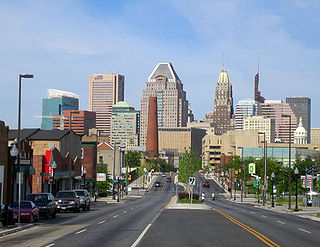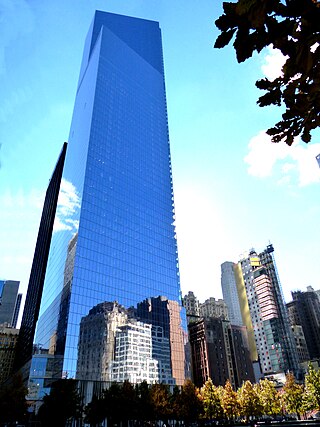
The first memorials to the victims of the September 11 attacks in 2001 began to take shape online, as hundreds of webmasters posted their own thoughts, links to the Red Cross and other rescue agencies, photos, and eyewitness accounts. Numerous online September 11 memorials began appearing a few hours after the attacks, although many of these memorials were only temporary. Around the world, U.S. embassies and consulates became makeshift memorials as people came out to pay their respects.

Fort McHenry is a historical American coastal pentagonal bastion fort on Locust Point, now a neighborhood of Baltimore, Maryland. It is best known for its role in the War of 1812, when it successfully defended Baltimore Harbor from an attack by the British navy from Chesapeake Bay on September 13–14, 1814.

7 World Trade Center is an office building constructed as part of the new World Trade Center in Lower Manhattan, New York City. The tower is located on a city block bounded by Greenwich, Vesey, Washington, and Barclay Streets on the east, south, west, and north, respectively. 7 World Trade Center was developed by Larry Silverstein, who holds a ground lease for the site from the Port Authority of New York and New Jersey, and designed by Skidmore, Owings & Merrill.

The National Aquarium – also known as National Aquarium in Baltimore and formerly known as Baltimore Aquarium – is a non-profit public aquarium located at 501 East Pratt Street on Pier 3 in the Inner Harbor area of downtown Baltimore, Maryland in the United States. Constructed during a period of urban renewal in Baltimore, the aquarium opened on August 8, 1981. The aquarium has an annual attendance of 1.5 million visitors and is the largest tourism attraction in the State of Maryland. The aquarium holds more than 2,200,000 US gallons (8,300,000 L) of water, and has more than 17,000 specimens representing over 750 species. The National Aquarium's mission is to inspire conservation of the world's aquatic treasures. The aquarium's stated vision is to confront pressing issues facing global aquatic habitats through pioneering science, conservation, and educational programming.

The Baltimore Convention Center is a convention and exhibition hall located in downtown Baltimore, Maryland. The center is a municipal building owned and operated by the City of Baltimore.
Baltimore City Community College (BCCC) is a public community college in Baltimore, Maryland. It is the only community college in the city and the only state-sponsored community college in the state. It is accredited by the Middle States Commission on Higher Education (MSCHE). It was founded in 1947 and has about 5,000 students enrolled in one of its campuses.

Harborplace is a shopping and dining complex on the Inner Harbor in Baltimore, Maryland.

The Inner Harbor is a historic seaport, tourist attraction, and landmark in Baltimore, Maryland. It was described by the Urban Land Institute in 2009 as "the model for post-industrial waterfront redevelopment around the world". The Inner Harbor is located at the mouth of Jones Falls, creating the wide and short northwest branch of the Patapsco River. The district includes any water west of a line drawn between the foot of President Street and the American Visionary Art Museum.

The Pride of Baltimore was a reproduction of a typical early 19th-century "Baltimore clipper" topsail schooner, commissioned to represent Baltimore, Maryland. This was a style of vessel made famous by its success as a privateer commerce raider, a small warship in the War of 1812 (1812–1815) against British merchant shipping and the world-wide British Royal Navy. After the end of the war, Baltimore Clippers did not have sufficient cargo capacity for normal merchant trade, so some were used in the illegal opium trade into China and vessels of the same type were used in the transatlantic slave trade from Africa.

Power Plant Live! is a collection of bars, restaurants and other businesses in the Inner Harbor section of downtown Baltimore, Maryland. It was developed by The Cordish Companies and opened in phases during 2001, 2002, and 2003. The entertainment complex gets its name from the nearby "Power Plant" building, three blocks south on municipal Pier 4 on East Pratt Street facing the Inner Harbor, which was also later re-developed by Cordish.

One World Trade Center, also known as One WTC and Freedom Tower, is the main building of the rebuilt World Trade Center complex in Lower Manhattan, New York City. Designed by David Childs of Skidmore, Owings & Merrill, One World Trade Center is the tallest building in the United States, the tallest building in the Western Hemisphere, and the seventh-tallest in the world. The supertall structure has the same name as the North Tower of the original World Trade Center, which was destroyed in the terrorist attacks of September 11, 2001. The new skyscraper stands on the northwest corner of the 16-acre (6.5 ha) World Trade Center site, on the site of the original 6 World Trade Center. It is bounded by West Street to the west, Vesey Street to the north, Fulton Street to the south, and Washington Street to the east.

100 Light Street is a 40-story, 528 ft (161 m) skyscraper completed in 1973 in downtown Baltimore, Maryland. It occupies the city block bounded by South Charles, East Lombard, Light and East Pratt Streets. It is the tallest building in Baltimore and in Maryland.

Downtown Baltimore is the central business district of the city of Baltimore traditionally bounded by Martin Luther King, Jr. Boulevard to the west, Franklin Street to the north, President Street to the east and the Inner Harbor area to the south.

The Helen Delich Bentley Port of Baltimore is a shipping port along the tidal basins of the three branches of the Patapsco River in Baltimore, Maryland, on the upper northwest shore of the Chesapeake Bay. It is the nation's largest port facility for specialized cargo and passenger facilities. It is operated by the Maryland Port Administration (MPA), a unit of the Maryland Department of Transportation.

4 World Trade Center is a skyscraper constructed as part of the new World Trade Center in Lower Manhattan, New York City. The tower is located on Greenwich Street at the southeastern corner of the World Trade Center site. Fumihiko Maki designed the 978 ft-tall (298 m) building. It houses the headquarters of the Port Authority of New York and New Jersey (PANYNJ).

100 East Pratt Street is a building located on Pratt Street in the Inner Harbor district of Baltimore, Maryland that consists of a ten-story concrete building finished in 1975 and a 1991 glass and steel twenty-eight story tower.

The Pentagon is the headquarters building of the United States Department of Defense, in Arlington County, Virginia, across the Potomac River from Washington, D.C. The building was constructed on an accelerated schedule during World War II. As a symbol of the U.S. military, the phrase The Pentagon is often used as a metonym for the Department of Defense and its leadership.

The Pratt Street Power Plant — also known as the Pier Four Power Plant, The Power Plant, and Pratt Street Station — is a historic former power plant located in downtown Baltimore, Maryland, USA. It has undergone significant repurposing development since retirement and was listed on the National Register of Historic Places in 1987.

Baltimore is the most populous city in the U.S. state of Maryland. With a population of 585,708 at the 2020 census, it is the 30th-most populous US city. Baltimore was designated an independent city by the Constitution of Maryland in 1851, and is the most populous independent city in the nation. As of 2020, the population of the Baltimore metropolitan area was 2,838,327, the 20th-largest metropolitan area in the country. When combined the Washington–Baltimore combined statistical area (CSA) had a 2020 population of 9,973,383, the third-largest in the country. Though the city is not located within or under the administrative jurisdiction of any county in the state, it is part of the Central Maryland region, together with the surrounding county that shares its name.
























